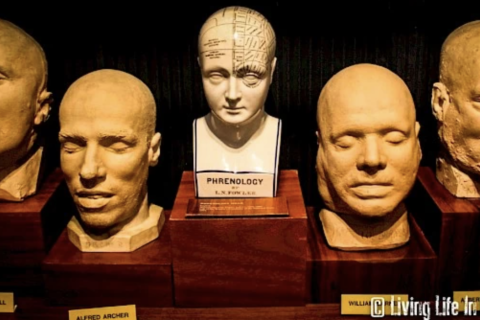

When roaming the halls of what was once a gaol, it is not uncommon for there to be displays and stories of former inmates. What is particularly unnerving, is the sight of a death mask. The Old Melbourne Gaol in Melbourne Victoria is full of them. Built in the mid 1800's, 133 hangings took place within its walls. The most infamous hanging was that of renowned bush ranger Ned Kelly. The gaol closed in 1924 and eventually decommissioned in 1929. The exercise yard at the gaol had during its years been used as a cemetery for the deceased. In 1929, the bodies were removed and put into coffins and transferred to Pentridge prison but not before people raided the cemetery to collect bones which they believed to be Kelly's where the initials NK were carved on the wall in the yard. His skull was taken home by one of the contractors working on the site Harry Lee who just a few days later returned the skull to the authorities. It eventually ended up in the gaol museum alongside his death mask. One fateful day in 1978, a curator found the skull was missing, and it has not been found. Whilst other bones have been identified through DNA samples and returned to his family for burial, the location of his skull is still unknown. More recently a WA farmer and Kelly enthusiast claimed to have the skull stored in a plastic container, however, it was later found to be an unidentified man whose bones had been stolen from the Pentridge raid. The skull was reunited and buried with its bone. There is a rumour the skull was originally used as a paperweight in the governor's office but there is no evidence to support this. A replica of his armour and death mask sits in the Old Melbourne Gaol to this day.

Image Source: Trove 1929
The Gaol itself sits today as a museum displaying one of the largest collections of death masks in all of Australia. So what is a death mask and why would you cast a mask of someone who was executed?
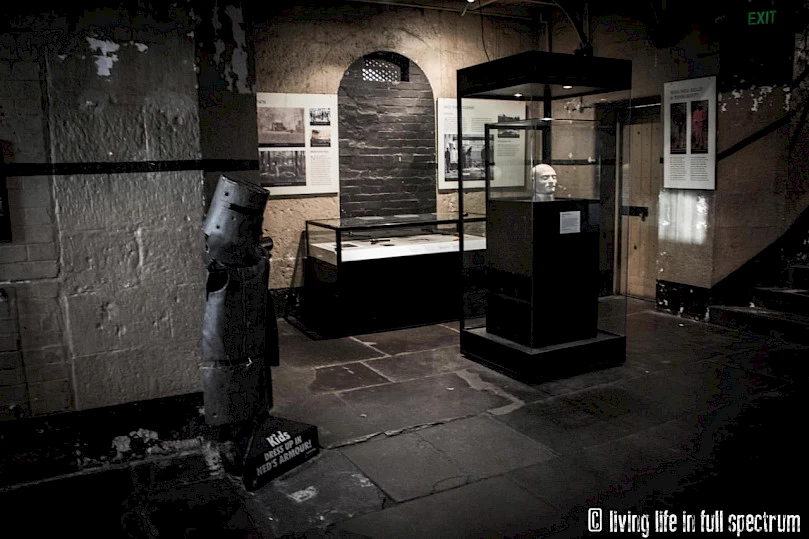
Death Masks
In some ancient cultures, they used what were called funeral masks as a part of the rituals they would perform when burying a body. In Ancient Egypt, they would mummify the body and put it into a sarcophagus decorated with various jewels. The finishing touch was to put a sculpted mask on the face of the deceased. This was considered to be a very important sacred element of the ritual. It was believed that the mask would strengthen the spirit of the mummy and guard it against evil on its way to the afterworld.
In the late 1880s, the process of casting death masks was used as a way to help identify the body of a missing person. If an unidentified body was presented, a mask was cast so that family members looking for missing loved ones could identify the body. Remember this is long before the technology we have today. There is, in particular, one mask known as L’Inconnue de la Seine. It was the face of an unidentified young woman who was found drowned at the Seine River in Paris sometime in the 1880s. She was believed to be around 16 years old. The morgue worker who cast the mask was bewitched by her beauty. The mask became quite popular and considered almost a work of art. If the face looks familiar, that is because the world’s first CPR mannequin was modelled after this very mask.
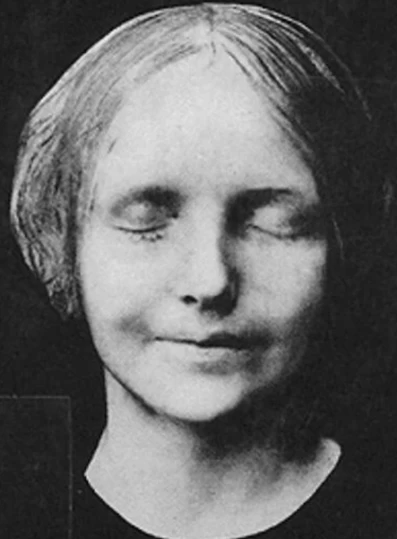
L'Inconnue de la Seine Image Source: Public Domain
In the 19th Century and early 20th Century, the process of casting death masks was used widely on inmates in prisons after they were executed. After they were hung, their head was shaved, and a cast would be taken. The intention of this was not solely to display the masks in a museum (even though that is what they are doing today). They were to be unknowing participants in a study called Phrenology.
Phrenology
Phrenology is considered to be a pseudo-medicine that is no longer practised as it has since been scientifically discredited. It was developed in 1796 by German physician Franz Joseph Gall. In 1820, the Edinburgh Phrenological Society was established. The process behind Phrenology involves feeling and observing the measurements of a human skull. The belief was that certain behaviours and traits were confined to different sections of the brain. It was believed there were around 27 different sections of the brain. A phrenologist would run their fingertips and palms over a person’s skull to see if they could feel any enlargements or indentations or in simple terms - feel the bumps. They would also measure the head. From these findings, a Phrenologist would assess the character and the temperament of the patient. There were considered to be 5 fundamental points to phrenology:
1. The brain is the organ of the mind.
2. The mind is composed of multiple, distinct, innate faculties.
3. Because they are distinct, each faculty must have a separate seat or "organ" in the brain.
4. The size of an organ, other things being equal, is a measure of its power.
5. The shape of the brain is determined by the development of the various organs.
6. As the skull takes its shape from the brain, the surface of the skull can be read as an accurate index of psychological aptitudes and tendencies.
Even though in the 1840s, Phrenology had been discredited as a Scientific Theory based on a large amount of evidence against it, the concept became popular again in the early 20th century. It was during this resurgence that it was thought criminals could be rehabilitated. The thinking was that a diagnosis could be made, and a plan put in place to help to rehabilitate the criminal. For example, a criminal with homicidal tendencies would be rehabilitated to work as a butcher to control his impulses. Somewhere along the way in this study, prisons would start to cast death masks on inmates who had been executed. They were not only used for the study of phrenology but also appeared in museums and material for prison authorities to use at lectures and even displayed as a deterrent for people – if you do the crime, this is what could happen to you.
Old Melbourne Gaol's Death Masks
Famous Australian Bushranger Ned Kelly's death mask is one of the most famous masks on display here, at the very place he was executed. In November of 1880, Kelly was hung for 3 counts of wilful murder and is said to have spoken his final famous words moments before his death:
“Such is life”
His is not however the original death mask, it is a copy. It was not uncommon for copies to be made as they are quite fragile. In addition to Kelly, there is an extensive collection of original death masks on display of executed inmates throughout the gaol.
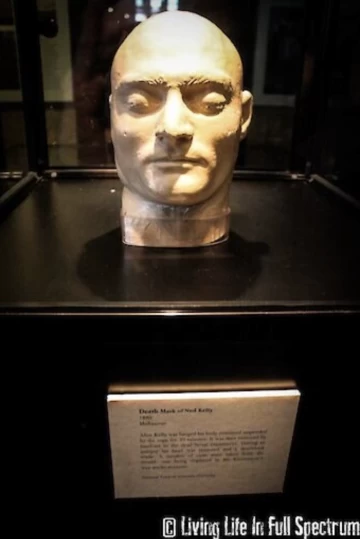
Ned Kelly's Death Mask (copy) on display at Old Melbourne Gaol
Bushranger George ‘Frenchy’ Melville was executed in 1853 for the McIvor Gold Robbery. Fatta Chand was also hung at the gaol in 1891 for the murder of his Hindoo partner Juggo Mull, even though he claimed his innocence. All others convicted of the same crime were charged but not executed.
The first woman to be hung at the Old Melbourne Gaol was Elizabeth Scott on the 11th of November 1863. In fact, she was the first woman to be hung in Victoria. She was executed alongside David Gedge and Julian Cross for the murder of her husband 6 months earlier. When Elizabeth was only 13 years old, she was coerced by her mother to marry Robert Scott who was a much older man and also an alcoholic. They ended up running a bush inn together near Mansfield for 10 years. They had 5 kids, 3 of whom died as babies. Elizabeth was friends with Gedge who worked at a nearby staging point for a coach run. Cross was hired to work as a general hand in her and her husband’s inn. When Robert Scott was drunk one night, Cross shot him and staged it to look like a suicide. When he was taken by police, he implied that Elizabeth and Gedge put him up to it as if they were in a relationship. The evidence pointed to this also. Elizabeth was 23 years old (and had already been married for 10) at the time of her execution. The two orphaned children were taken by police to the Orphan Asylum at Emerald Hill.
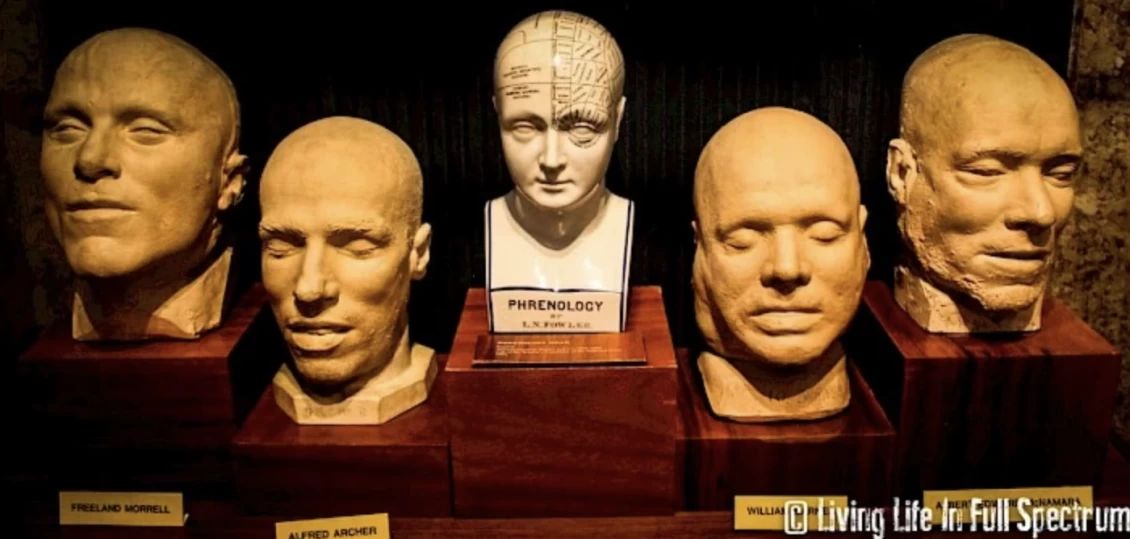
What is eerie about these masks is the expression on the faces of the subjects. Some seem at peace. Others have a look of distress. One even seems to have a smirking smile. In some cases, you can actually see the contortion in the neck from where they were hung. Strands of facial hair are even sticking out from the plaster on others. I have to wonder if the energy of the person and the trauma associated with their death is embedded within the masks. While they are displayed behind solid Perspex, the energy of the deceased remains in the very place they met their demise. Is this why so many people feel ill and uneasy in their presence?
This is just another example of how our strange past and intrigue with the macabre fascinates us still to this day. I know I can’t be around a death mask for long. Whether I am feeling the energy of the mask or if maybe I am just a little bit creeped out, either way, it doesn’t sit well with me.
If you enjoy LLIFS, consider buying me a book (otherwise known as buy me a coffee but I don't drink coffee and I LOVE books). Your donation helps to fund the LLIFS website so everyone can continue to access great paranormal content and resources for FREE!

Top pages with similar subjects
Don't forget to follow the Facebook page for regular updates
Join the mailing list to receive weekly updates of NEW articles. Never miss an article again!
Buy the latest and past issues Haunted Magazine
Check out the books written by LLIFS